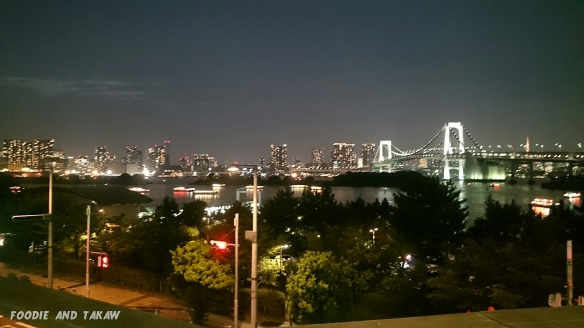The afternoon we spent in Odaiba was very, very tiring! Odaiba is a man made island in Tokyo Bay. Ang dami naming nilakad! There are several malls in Odaiba and we went inside all of ’em.

Before heading to Odaiba, we passed by the Nippon Television Tower and saw this yellow thingie that Miko called PIKACHU. No kids, that is not a Pokémon. I have no idea who that is. :p

Odaiba was initially built for military purposes in the 1800s, and expanded as a seaport district in the late 20th century, and has developed since the 1990s as a major commercial, residential and leisure area

One of the most popular things to see is the Rainbow Bridge. This is the bridge by day–

The first mall that we visited (because it’s the closest to the train station) was Decks. Ang ganda. Mukha talagang decks with its wooden flooring. :D

We had snacks at Anchors,

just some assorted sausages, juice, and cola.

But because my newbie legs and feet were aching from all the walking, I begged Miko that we stay a little longer and we had more refreshments. :P

When I got some of my strength back, we went to Aqua City

and we saw a replica of the Statue of Liberty. According to Wiki, The French Statue of Liberty came to Odaiba in the late 90’s in commemoration of “The French year in Japan”. Because of its popularity, in 2000 a replica of the French Statue of Liberty was erected at the same place.

I don’t remember if LEGOLAND is inside this mall, but we decided not to visit it anymore, because there was still so much to see in the area. Like this Hello Kitty Store.

Akalain mong pati dried fish at dried squid meron si Hello Kitty?

Look at this Kitty Geisha! Ang cute cute!

In Diver City Plaza, there’s the famous 18 meter tall Gundam statue!

Katuwa kasi even the locals seemed excited to see the humongous robot.

There’s this golden structure of some sort that caught our attention. Don’t know what it is, but it’s just magnificent.

Here’s a better shot. Better kasi may sunflowers. I love sunflowers! :D

And there’s a kiddie program being shot in the area. No, babe. That’s not Mojacko. :p

And this architectural masterpiece is the Fuji television Headquarters. The building was designed by world-renowned Kenzo Tange. he also designed St. Mary’s Cathedral in Bunkyo. (I’ll be blogging about that soon.)

Walang pinipiling lugar ang Minions. Pati pala sa Japan, popular sila!

Hello there, Stuart, Bob and Kevin!

Here’s our family portrait. Charot! :p

Of course, Dragon Ball is popular here.

And lucky cats.

And this blue dog that’s called LAUGH THE DOG, No, baby. Hindi siya si Snoopy na nalubog sa asul na jobos. :p

Miko looked for Tekken, but didn’t find the game in the arcade. (Naging successful naman siya when we went to Shinjuku a couple of days after.)

And look! There’s Astroboy again! Ang sarap iuwi at isabit sa kwarto ko!

Do you remember the Monchhichis? They used to have an animated tv series in the 80’s. Ang tawag ko nga sa kanila Ewoks. Hahaha. Eh baket ba, pareho naman silang furry.

Saw this shop that stationery, fans, toiletries, etc. I took a photo of it because I like the store name. Wabi-Sabi is a Japanese concept that deals with one of beauty that is imperfect, impermanent, and incomplete. It is also a noodle shop at The Collective. :p

Then finally, darkness fell and we saw the lights of the bay and the Rainbow Bridge.

Unfortunately, we didn’t see the bridge’s rainbow colors, but the view was still stunning. The towers supporting the bridge are white in color, designed to go with the skyline of central Tokyo. Lamps are placed on the wires supporting the bridge, which are illuminated into three different colors, red, white and green every night using solar energy obtained during the day.

The rainbow lights we got to see were from the Daikanransha, located at Palette Town. It is one of the biggest ferris wheels in the world. The wheel is brightly lit by neon tubes programmed to display multiple patterns in over 100 colors.

Hay Odaiba, nakakapagod kang galaan! But oh so fun!
Next stop– Shibuya!
*featured image from Wikipedia
// listening to Adele – Hello









































































